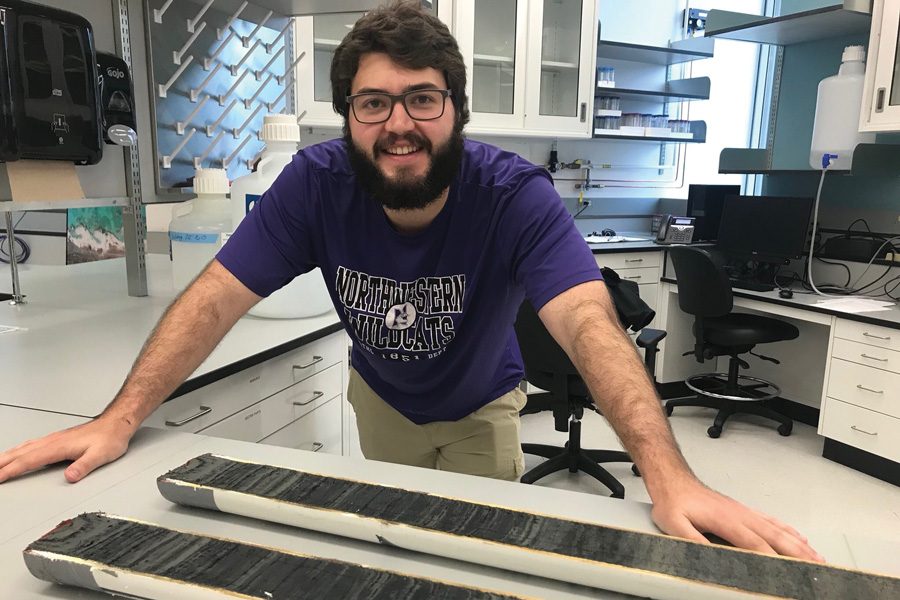NU professors, students working to create historical climate map of Midwest
Weinberg junior Peter Puleo. In Earth and Planetary Sciences Prof. Yarrow Axford’s lab, Puleo has worked with lake sediment cores, which are tubes of mud with visible bands of different colors and minerals.
May 31, 2018
Picture the dirt at the bottom of a lake: It may seem slimy, squishy and unappealing.
But for Earth and Planetary Sciences Prof. Yarrow Axford’s research team, that sediment is key to understanding the Midwest’s past climate, or “paleoclimate.”
Peter Puleo, a Weinberg junior, has been working with Axford to study layers of lake sediment — collected in tubes of mud called “cores” — to reconstruct the history of southeastern Wisconsin’s climate.
The sediment data can then be compared to existing climate data from past studies by other researchers of pollen. This will solidify findings about how the Midwest’s climate has changed over time, Puleo said.
“There was a recent study put out that said the southern Great Lakes region had a strange temperature discrepancy from the rest of the Midwest,” Puleo said. “We’re looking to see if we can find a temperature lag in the sediments we’re studying.”
Using chemical testing and radiocarbon dating, Puleo hopes to create a detailed timeline of the area’s climate history. Within the next year, he hopes to have a record and map of temperature or precipitation shifts for at least the past 10,000 years, he said.
The data will help predict how the planet will respond to man-made changes, research team members said. Axford, who has done similar work with lakes in the Arctic, said it’s important to understand those effects in the Midwest, especially.
“As a nation, we need to know more about what happens in the agricultural heartland of our country when climate changed in the past,” Axford said. “It will give us somewhat of a roadmap for what to expect in the future.”
To collect cores, the team traveled to Geneva Lake in Wisconsin. Geneva Lake has close to 100 feet of thick and “beautifully layered” sediment at its bottom, Axford said.
Over five days, the group spent hours on a boat using Axford’s equipment to draw cores from the lake’s floor, Puleo said. Those cores are cylinders of lake sediment 4 meters long and 7.62 centimeters in diameter, with visible bands of different colors and minerals. They were then split into three sections and cut down the middle.
Everett Lasher, a Ph.D. student from Axford’s lab who attended the trip, has studied cores from Greenland in the past, but never from the United States. The findings from Geneva Lake should provide a lot of background on the area, he said.
“We’re really excited to see how old it is at the bottom, how deep into time we get. There’s some really interesting sedimentary features,” Lasher said. “Maybe there’s early human activity recorded in this lake, that would be pretty cool.”
The group will have to wait for test results to know what chemicals and biological materials they have to work with and to study, along with what methods they can apply, Axford said.
Puleo is in the process of analyzing the cores now. With the help of Earth and Planetary Sciences research associate Mitchell Barklage, he will decode and understand the chemical messages within the cores by using reflected sound waves to create images of sediment layers. Other department members, including Earth and Planetary Sciences Prof. Maggie Osburn, will look for indicators of past climate change using biological materials.
“It’s the early, fantasizing ‘what might be possible’ stage until we learn more about how old the mud actually is and how well various ingredients of the mud are actually preserved,” Axford said. “This is just the very, very beginning.”
Email: rachelkupfer2021@u.northwestern.edu
Twitter: @rachkupfer



